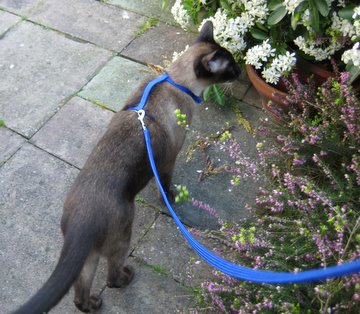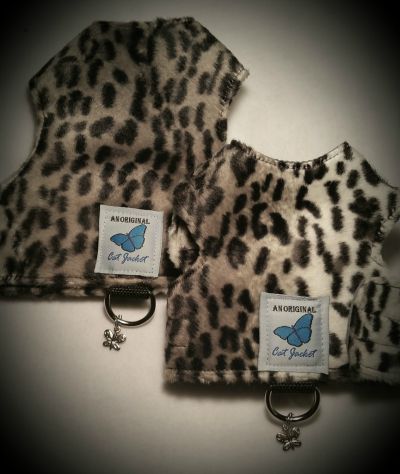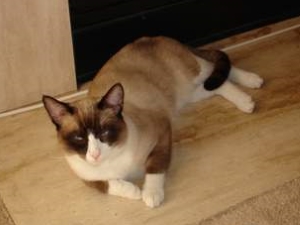- Home
- Meezer Musings
- June 2023
Meezer Musings: June 2023
Cats in Harness
Welcome to June's Meezer Musings! We've reached mid-summer, and that means heat. Many of us have been experiencing extremes of temperature and humidity, bringing in their wake the threat of heatwaves, drought and forest fires or alternatively, storms and floods.
I know there are those among you who've had to face some or all of these weather events in the past couple of months and I sincerely hope you've been able to stay safe and out of harm's way.
Even if you're not affected by unusually high temperatures, the summer months can bring challenges for all cat owners, and towards the end of this page you'll find our Topical Tips for keeping your cats cool in the heat.
But first ...
Harness Training for Cats
We've talked in the past about ways to keep your cat safe while still giving them a taste of the outdoor life. Prompted by a recent question about cat harnesses, this month we're taking a look at how to train your cat to walk on a leash.
Some cats take to a harness like a duck to water and some ... don't! However, with time and patience it can be possible. The photo below shows Bandit in a moment of calm, but believe me, things weren't always like this!
 Relaxed and happy. Siamese cats can learn to love harnesses
Relaxed and happy. Siamese cats can learn to love harnessesImage copyright © Life with Siamese Cats
Training cats to walk in a harness has become increasingly popular in recent years, as it enables owners to take their cats outside in relative safety.
Some cat breeds may need more patience and effort to adapt to harnesses than others, but Siamese cats, who are, after all, known for their intelligence and active nature, adapt very well to life on a leash and there are examples of this in many of the Siamese cat groups on Facebook and elsewhere, as well as in older photos of the breed.
Siamese cats are quick learners and enjoy mental stimulation and new challenges (as anyone with a Siamese that's learned how to open fridge doors will know) but even so, it's really important to make harness training an engaging and positive experience, taking things slowly and gradually and using patience and consistency.
Not all cats learn at the same pace and even the most curious and intelligent of Siamese cats may initially resist the idea of wearing a harness.
Choosing the Right Harness
Uncomfortable straps may put your cat off harnesses for life, so choosing the right style is essential both for the comfort and, especially, safety of your cat.
In Bandit's first years with us I trained him quite successfully with a small dog harness (seen in the photo above) but it wasn't an ideal design. The straps fastened with buckles, which weren't easy to do up and undo.
Additionally, narrow straps like these can constrict or chafe a cat's body. Even worse, Bandit managed to escape from this harness several times.
A much better option are harnesses created especially for cats, like the one shown below produced by Butterfly Cat Jackets for their own strong, active, Bengal cats.
In this design, the fastenings are made with Velcro and can be adjusted to fit snugly around the neck and abdomen. As you can see from the one Bandit is wearing below, the wide panels provide a comfortable (and even comforting) experience.
Butterfly Cat Jackets say they've never known cats to escape from their harnesses and although, to my mind, where cats are concerned nothing is 100% foolproof, these are certainly strong and well crafted.
These jackets are hand-made, so if you have a particularly large or small cat they can be tailored to your cat's measurements. The jackets don't come with a leash unless specified, but they're available in a variety of fun patterns and colors, giving you plenty of design choices.
If you'd like to know more you can find them on Facebook, or their website, or on Etsy, where there's a wonderful display of all their various designs.
 Harness from Butterfly Cat Jackets
Harness from Butterfly Cat JacketsImage copyright © Life with Siamese Cats
Getting Your Cat Used to the Harness
Once you've found a harness, the next step is to get your cat used to it.
Before you even attempt to put it onto your cat, begin by leaving the harness, without a leash attached, somewhere where your cat can sniff and explore it in their own time and get to this new object without feeling in any way threatened.
You could also help to make it 'smell right' by rubbing it gently across your cat's body a few times or using it as a toy for them to play with.
Provide treats, praise, or play whenever your cat shows interest in the harness and they'll soon come to associate the harness with happy times.
Harness Fitting Sessions
Once your cat is used to seeing the harness around, you can start fitting it to your cat. Keep these first sessions short, gently slipping the harness onto your cat's body, fastening it snugly but not too tightly.
Providing lots of treats while you do this will distract your cat's attention and if you're lucky, they'll pay very little attention to the harness,
It should go without saying that you need to do this indoors - don't attempt to go outside at this point!
Let your cat wear the harness for short periods while at the same time offering treats and praise, but don't attach a leash or attempt to get your cat walking in the jacket.
(If you don't take this step very slowly and gradually, what will probably happen is that your cat, feeling this new, strange and possibly unpleasant thing around their body, will fall over on their side and flatly refuse to move. Ask me how I know ...)
Leash Training
Once your cat is comfortable and used to wearing the harness around the house without anything attached to it, you can add a leash. And then, with supervision, let your cat move around indoors, allowing them to go wherever they want to go.
Avoid pulling or tugging on the leash - just let your cat get used to the sensation of having the leash attached and of course, continue to provide lots of praise and treats!
The Great Outdoors
Finally, once your cat is comfortable wearing the harness and walking with the leash indoors, you can take your first steps outside. Start in a quiet, secure outdoor area - ideally a fenced garden or yard or a quiet park - to allow your cat to safely experience all the new sights, sounds and smells.
Success! And a Warning
Once your cat is comfortable and steady in a safe outdoor area, you can, if you wish, venture further afield. However, you should always remember that cats may at any time become skittish when they see something unusual or frightening and their tendency is to run - not necessarily in the direction that you might expect.
So it's probably best to avoid crowded areas, especially those known to be busy with traffic, dogs, or other cats.
This brings us to our second safety topic for the month, and our Topical Tips for keeping your cats cool in the summer heat.
Topical Tips for Summer Heat
Cats usually enjoy warm weather and are fairly heat tolerant, but can suffer from dehydration and heatstroke when temperatures soar.
With that in mind, here are ten tips for keeping your cat cool, healthy and happy in the summer months.
- Supply plenty of fresh cold water. This is always important, but in hot weather water evaporates very quickly. Check bowls regularly; clean them out and fill them up. Some cats like ice cubes
added to their water, some don't, so to experiment, provide a choice of iced and non-iced water. Don't use too
much ice though - one or two cubes is plenty to keep the water fresh without
over-chilling it.
- Feed wet food. Some cats don't drink enough, which can be a problem in hot weather. If you usually feed dry foods, consider switching to wet meals and adding water to them. Many cats love licking gravy, and adding water is a sneaky way of getting more fluid in.
- Provide shade and airflow. Indoors (and outdoors, if your cat's allowed out) make sure there's a cool, quiet, shady area they can retreat to. Keep curtains closed or shades drawn when the sun's on the windows. Rooms with ceiling fans for airflow are helpful too.
- Make cool spots. Many cats love lying on cool, tiled kitchen floors when it's hot, others choose to curl up in sinks, showers or baths. Laying wet towels down in these areas can help. It's possible to buy self-cooling mats for pets, but you can create cool spaces yourself by placing ice packs in cotton pillowcases in places where you cat likes to lie, or filling water bottles with ice cold water and placing them in cardboard boxes for your cat to find and use if they need to.
- Avoid too much play. Exercise generates heat, so keep play to a minimum in hot weather.
- Groom cats daily. In long-haired cats especially, matted fur can trap heat. Fur with no tangles allows air to flow freely through the coat. Daily brushing (for all cats) removes excess fur and helps to keep them cool.
- Check your outside buildings.
Inspect sheds, greenhouses, and summerhouses before closing them up.
Cats often creep inside for shade, but will dehydrate and die very
quickly in hot enclosed spaces without water.
- Avoid parked cars. Never leave cats alone in parked cars. On trips to the vet or on vacation, make sure the cat's in a secure cat carrier, use air-conditioning if you have it, open the windows if you have to park, and stay with the cat to keep an eye on it.
- Check for dehydration. Pinch the skin at the back of your cat's neck - it should spring back immediately. If it doesn't, chances are they're dehydrated. Dehydration can be serious so always seek veterinary advice.
- Watch for signs of heatstroke.
Panting, drooling, vomiting, listlessness or lethargy, dilated pupils
and a rapid heartbeat are all signs of heatstroke. If you notice any of
these things take your cat to the vet immediately. You can help to cool your
cat down on the way by sponging their heads and coats with cold, damp,
towels.
Tail End ...
In last month's Meezer Musings I wrote about the Ragdoll and Birman cat breeds and after I sent it out, I was contacted by David, a breeder of Tonkinese cats in New Zealand, who told me that there's no evidence that Birmans originally came from Burma.
So I went back to the breed books to investigate and it seems that this idea of Birmans originating in Burma may have been put about by the original French creators of the breed, wishing to create mystery and romance around the breed's origins ... which, it appears, they certainly did!
That's all for June, but I should be back at the end of July. Until then I hope you have a safe, happy and 'Goldilocks' month - not too hot, not too cold, somewhere in the middle and just right!
Caroline
Missed a Meezer Musings? A list of previous newsletters can be found here.
Some of the articles and newsletters on this site may contain links to products I think you may enjoy. If
you purchase through these links I receive a small commission, but there's
no extra cost to you. Find out more on the Affiliates Disclosure page.
Have You Discovered Our Newsletter?
If not, why not? Subscribe to our email newsletter, Meezer Musings, to stay in touch, be the first to see new information and pages as they come out, and read the things we only talk about in the newsletter.
Learn more about it on our Newsletter Sign-Up page.





